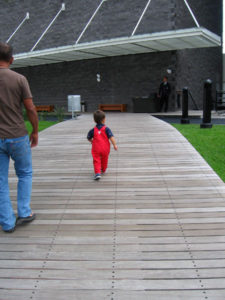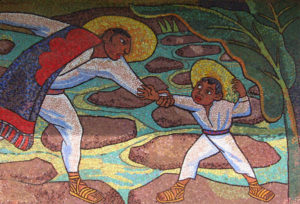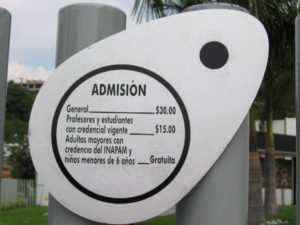Muros, which means “walls” in Spanish, opened to the public in May of 2004. It is the only museum in Cuernavaca, Morelos originally designed to be a museum. The space is flexible with movable lighting, high ceilings and open areas in which display environments can be constructed. The museum gets its name from its 3,600 square meters of wall space. Even more important than the walls are the professional, organized, staff members who are stationed throughout the museum and who support the visitor’s experience. Muros’ staff provides the real heart of the museum.
The entrance to the museum is wide open and welcoming. As you approach the museum, you first encounter a tourist information table staffed by both museum and Morelos tourist department personnel where you can get information about Muros and other attractions throughout the state. As the author purchased tickets for a second visit to the museum, she was carrying her toddler on her back and the man in charge offered a stroller for the visit. Often there is someone standing at the large, glass doorway to hold the door open and tell you, “Bienvenidos.”
In the courtyard area in front of the museum you is an original tile mosaic credited to Diego Rivera. It was originally built near the swimming pool of a private home and depicts native Mexicans bathing in a stream. A mother is washing her son, a father trying to coax another son to bathe as well, and other people are splashing water on themselves. Walk around the other side of the mural and you see… the other side of the scene.
Inside the museum there is a sense of space and ease of movement. Muros feels modern and everywhere you go you hear the sound of fans quietly turning and air moving in the exposed ventilation ducts. An upstairs area displays the formerly private collection of Jacques and Natasha Gelman, which the museum is proud to maintain in Cuernavaca. The collection provides a nice cross section of important Mexican art without being overwhelming. There are pieces by Diego Rivera, Carlos Orozco Romero, David A. Siqueiros, Frida Kahlo, and Rufino Tamayo, among others, and a timeline that provides an overview of the artists in the framework of world events during their lives. Downstairs, there are rotating displays of additional artwork. There is also a large room with restored murals that provides an area for events and temporary expositions. Throughout the museum, art of a wide variety of media and textures – such as metal, tile, hair, cardboard, glass, canvas, and video – are on display. The titles of works are clearly listed in both Spanish and English. There are also comfortable computer consoles, with standing perches that offer additional information on the artist’s lives and works as well as a carpeted reading area with cushioned seats and lots of books about art.
At the time that the author and her family visited, there was an interactive display about the life and work of Diego Rivera, which was specially designed for children. It provided a fun time for all members of the family. The open space had been divided into smaller “rooms,” each with a different theme from Rivera’s life. Most rooms had something for a 1 and a ½ year old. There were tiles you could move around to make a tile mural and hats to wear. But the most fun of all were masks and costumes of characters from one of his murals. We spent a lot of time putting on masks and peering at ourselves in the mirror provided just for that purpose.
Muros is more of a success story than you might guess because it was first conceived as a kind of olive branch to certain members of the Cuernavaca community. It is situated to one side of a large grocery store/parking lot complex developed on the site of what had previously been the Casino de la Selva. Casino de la Selva (Jungle Casino) was a distinctive entertainment location at the heart of today’s Cuernavaca since the 1930s. It was surrounded by tall walls and had fallen into severe disrepair over the years since its closing. For many years, only trespassers saw the grounds inside the walls, but the thick tree canopy on the property was obvious to all who passed by. When construction began on the property, many Cuernavacan’s were outraged that two huge grocery stores, a restaurant, and extensive parking lot would replace the Casino and its trees. Long, intense protests were staged to try to stop the development and suggestions were made that the property would better serve the community as a park. In the end, the grocery store chain was allowed to develop the site, but the idea of the community center was generated as a way to try to respond to the community outcry.
So far Muros has delivered to Cuernavacan community of all ages of the. Laura Perez, who is in charge of the program Muros para los Niños de Morelos (Muros for the Children of Morelos) plans many guided visits and workshops for school children. Her goal, she says, is to connect the children’s activities and particular pieces of art with something that they are currently studying in school, usually in the subjects of history, art, or civismo (loosely translates as civics, but with a more sociological focus). When I asked her which was her favorite children’s activity so far, it was hard for her to pick because they have been so varied and unique.
One activity she mentioned was for children learning geometry. They were shown pieces of art that exemplified geometric features and the students were thrilled to find the triangles, circles, etc. that they were learning about in school. Another workshop involved sitting in front of a mirror and doing a self portrait just like Frida Kahlo did. Laura said that she enjoyed seeing how some kids noticed and depicted tiny details, such as wrinkles on their faces while others exaggerated certain features like a large nose.
Every Saturday and Sunday, Muros offers workshops for children that relate to the temporary exhibits. In this way, if the exhibits aren’t designed for children – meaning you aren’t supposed to touch things, specifies Laura – children can still be involved. These workshops are offered from 11 to 2, and the cost is just that of the materials used.
Museum Cost, Hours, and Facilities
The museum is open Tuesday through Sunday from 10 a.m. to 6 p.m. and admission costs 30 pesos; children under six years old and older people with a special card are free. There are teacher and student discounts that reduce the price to 15 pesos with an I.D. Admission is free for everyone on Sundays and Tuesdays. There is a convenient, centrally located elevator just in front of the spotlessly clean restrooms so that wheelchairs can easily access the second floor. Take a look at the museum’s web site.
Don’t worry about parking, because there is plenty available. To get to the museum, enter the parking lot from any of the three Mega Commercial/Costco entrances. The museum is to the left of the California restaurant as you face it from the parking lot. There are a plethora of buses that will get you to the three entrances including any routes that say Plaza (for Plaza Cuernavaca, the mall almost directly across the street from one of the parking lot entrances) on them, as well as the 2 and 7 that say Tunel (enter near the grocery store named “Mega”), and the 18 (enter near the hospital).
I learned many new things on my visits to Muros. I’ll leave you with one of them. Guess how many names Diego Rivera had? Ten. That’s right. His full name was Diego Maria Concepción Juan Nepomuceno Estanislao de la Rivera y Banientos Acosta y Rodríguez.
Much thanks to the following Sources:
- Lagarde Lozano, René. “Diseño y Funcionalidad en el Edificio de Muros” [Design and Function in Muros]. 26 September 2007. Diario de Morelos. p6.
(for information about the building and the development of the site) - Dumay, María Gabriela. Las 10 Mejores Obras de Muros [The Top 10 Works at Muros]. 26 September 2007. Diario de Morelos. p12-13.
(for information about the collection of Jacques and Natasha Gelman)













